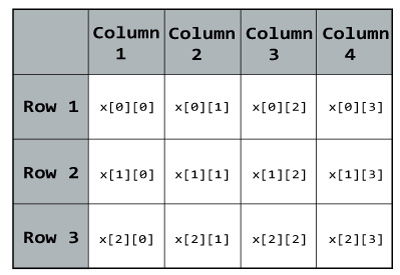C++ Multidimensional Arrays
In this article, you'll learn about multi-dimensional arrays in C++. More specifically, how to declare them, access them and use them efficiently in your program.
In C++, you can create an array of an array known as multi-dimensional array. For example:
You can think this array as table with 3 rows and each row has 4 columns as shown below.

Three dimensional array also works in a similar way. For example:
int x[3][4];Here, x is a two dimensional array. It can hold a maximum of 12 elements.
You can think this array as table with 3 rows and each row has 4 columns as shown below.

Three dimensional array also works in a similar way. For example:
float x[2][4][3];This array x can hold a maximum of 24 elements. You can think this example as: Each of the 2 elements can hold 4 elements, which makes 8 elements and each of those 8 elements can hold 3 elements. Hence, total number of elements this array can hold is 24.
Multidimensional Array Initialisation
You can initialise a multidimensional array in more than one way.Initialisation of two dimensional array
int test[2][3] = {2, 4, -5, 9, 0, 9};
Better way to initialise this array with same array elements as above.int test[2][3] = { {2, 4, 5}, {9, 0 0}};
Initialisation of three dimensional array
int test[2][3][4] = {3, 4, 2, 3, 0, -3, 9, 11, 23, 12, 23,
2, 13, 4, 56, 3, 5, 9, 3, 5, 5, 1, 4, 9};
Better way to initialise this array with same elements as above.int test[2][3][4] = {
{ {3, 4, 2, 3}, {0, -3, 9, 11}, {23, 12, 23, 2} },
{ {13, 4, 56, 3}, {5, 9, 3, 5}, {3, 1, 4, 9} }
};
Example 1: Two Dimensional Array
C++ Program to display all elements of an initialised two dimensional array.#include <iostream>
using namespace std;
int main()
{
int test[3][2] =
{
{2, -5},
{4, 0},
{9, 1}
};
// Accessing two dimensional array using
// nested for loops
for(int i = 0; i < 3; ++i)
{
for(int j = 0; j < 2; ++j)
{
cout<< "test[" << i << "][" << j << "] = " << test[i][j] << endl;
}
}
return 0;
}test[0][0] = 2 test[0][1] = -5 test[1][0] = 4 test[1][1] = 0 test[2][0] = 9 test[2][1] = 1
Example 2: Two Dimensional Array
C++ Program to store temperature of two different cities for a week and display it.#include <iostream>
using namespace std;
const int CITY = 2;
const int WEEK = 7;
int main()
{
int temperature[CITY][WEEK];
cout << "Enter all temperature for a week of first city and then second city. \n";
// Inserting the values into the temperature array
for (int i = 0; i < CITY; ++i)
{
for(int j = 0; j < WEEK; ++j)
{
cout << "City " << i + 1 << ", Day " << j + 1 << " : ";
cin >> temperature[i][j];
}
}
cout << "\n\nDisplaying Values:\n";
// Accessing the values from the temperature array
for (int i = 0; i < CITY; ++i)
{
for(int j = 0; j < WEEK; ++j)
{
cout << "City " << i + 1 << ", Day " << j + 1 << " = " << temperature[i][j] << endl;
}
}
return 0;
}Enter all temperature for a week of first city and then second city. City 1, Day 1 : 32 City 1, Day 2 : 33 City 1, Day 3 : 32 City 1, Day 4 : 34 City 1, Day 5 : 35 City 1, Day 6 : 36 City 1, Day 7 : 38 City 2, Day 1 : 23 City 2, Day 2 : 24 City 2, Day 3 : 26 City 2, Day 4 : 22 City 2, Day 5 : 29 City 2, Day 6 : 27 City 2, Day 7 : 23 Displaying Values: City 1, Day 1 = 32 City 1, Day 2 = 33 City 1, Day 3 = 32 City 1, Day 4 = 34 City 1, Day 5 = 35 City 1, Day 6 = 36 City 1, Day 7 = 38 City 2, Day 1 = 23 City 2, Day 2 = 24 City 2, Day 3 = 26 City 2, Day 4 = 22 City 2, Day 5 = 29 City 2, Day 6 = 27 City 2, Day 7 = 23
Example 3: Three Dimensional Array
C++ Program to Store value entered by user in three dimensional array and display it.#include <iostream>
using namespace std;
int main()
{
// This array can store upto 12 elements (2x3x2)
int test[2][3][2];
cout << "Enter 12 values: \n";
// Inserting the values into the test array
// using 3 nested for loops.
for(int i = 0; i < 2; ++i)
{
for (int j = 0; j < 3; ++j)
{
for(int k = 0; k < 2; ++k )
{
cin >> test[i][j][k];
}
}
}
cout<<"\nDisplaying Value stored:"<<endl;
// Displaying the values with proper index.
for(int i = 0; i < 2; ++i)
{
for (int j = 0; j < 3; ++j)
{
for(int k = 0; k < 2; ++k)
{
cout << "test[" << i << "][" << j << "][" << k << "] = " << test[i][j][k] << endl;
}
}
}
return 0;
}Enter 12 values: 1 2 3 4 5 6 7 8 9 10 11 12 Displaying Value stored: test[0][0][0] = 1 test[0][0][1] = 2 test[0][1][0] = 3 test[0][1][1] = 4 test[0][2][0] = 5 test[0][2][1] = 6 test[1][0][0] = 7 test[1][0][1] = 8 test[1][1][0] = 9 test[1][1][1] = 10 test[1][2][0] = 11 test[1][2][1] = 12As the number of dimension increases, the complexity also increases tremendously although the concept is quite similar
